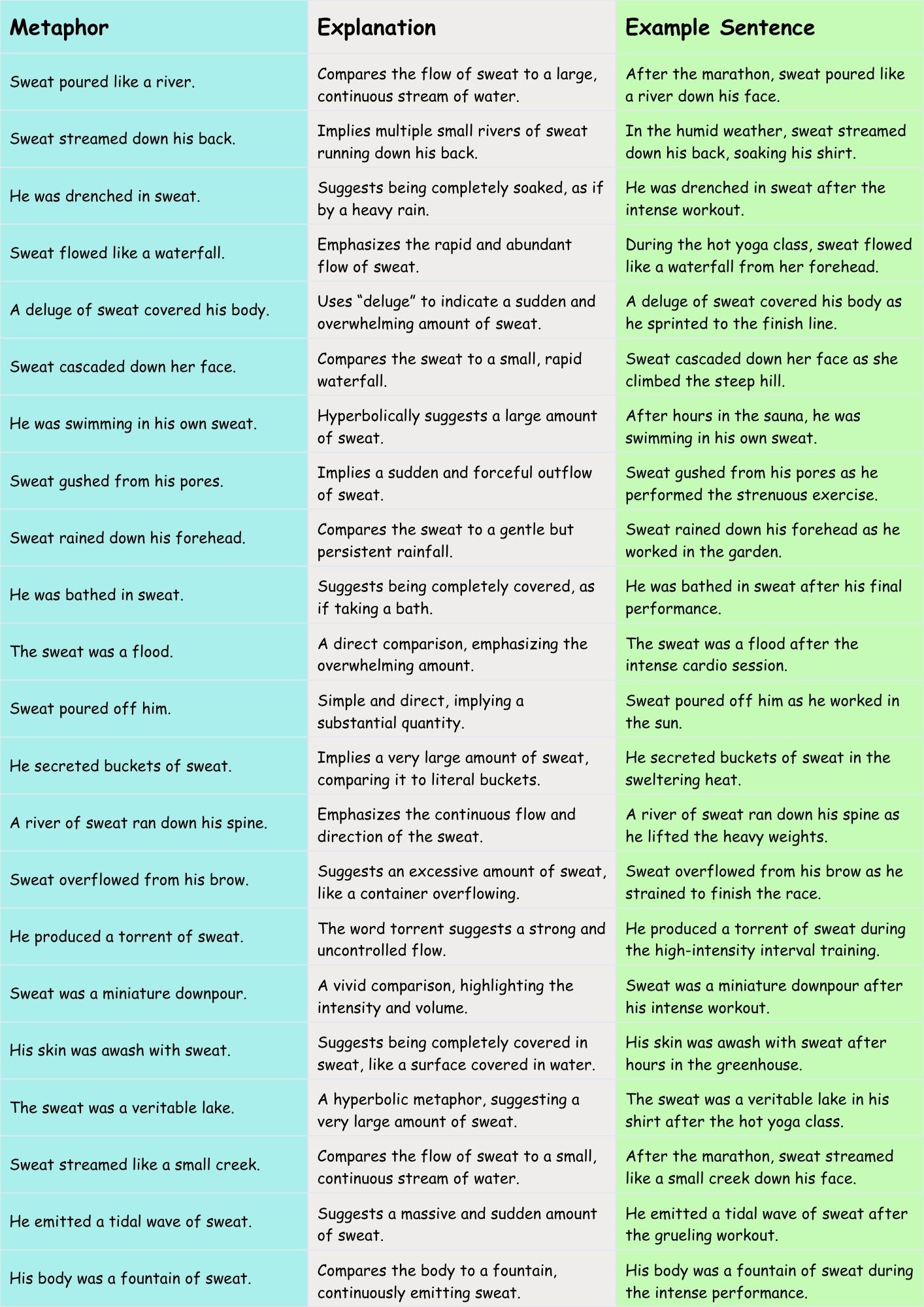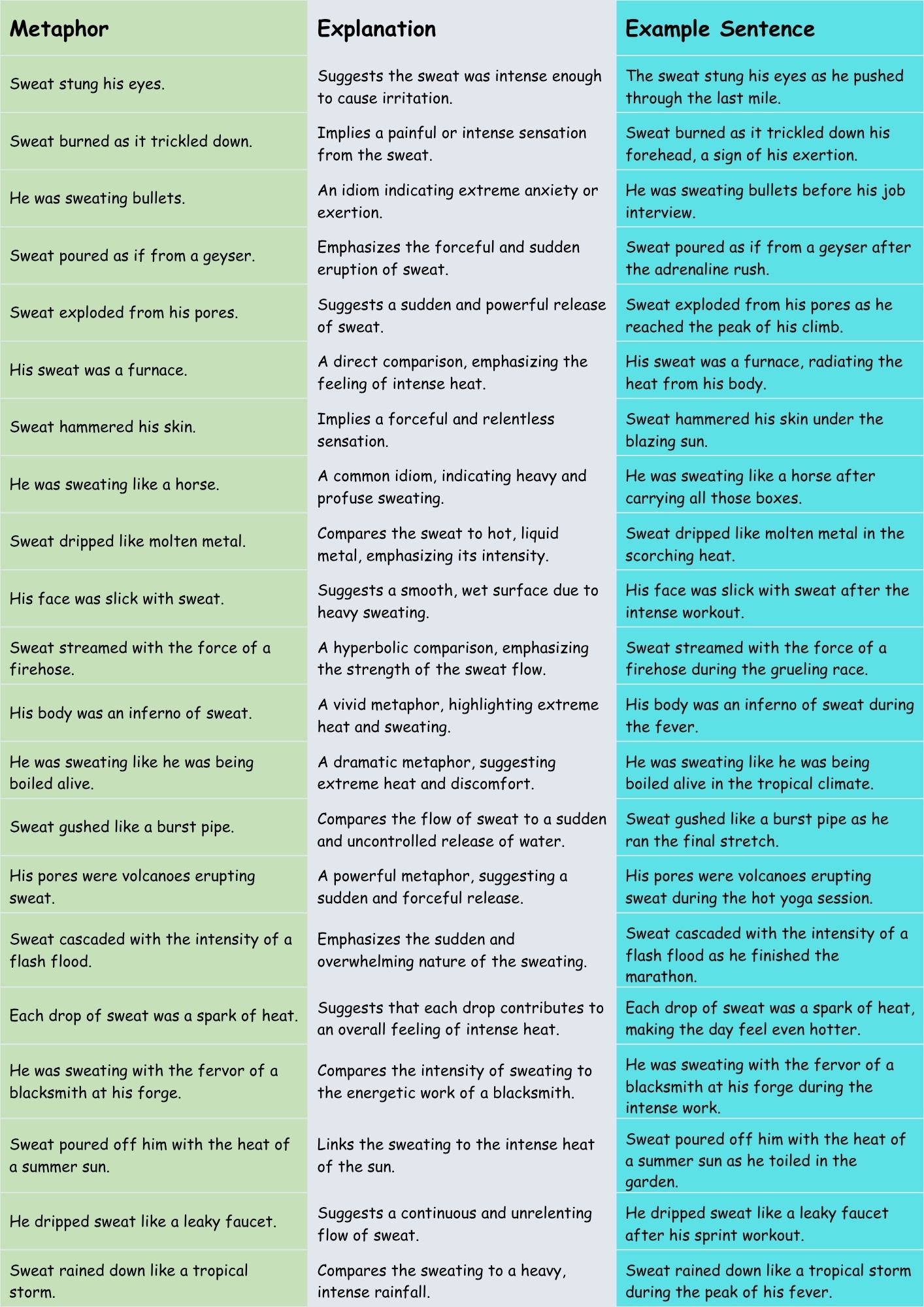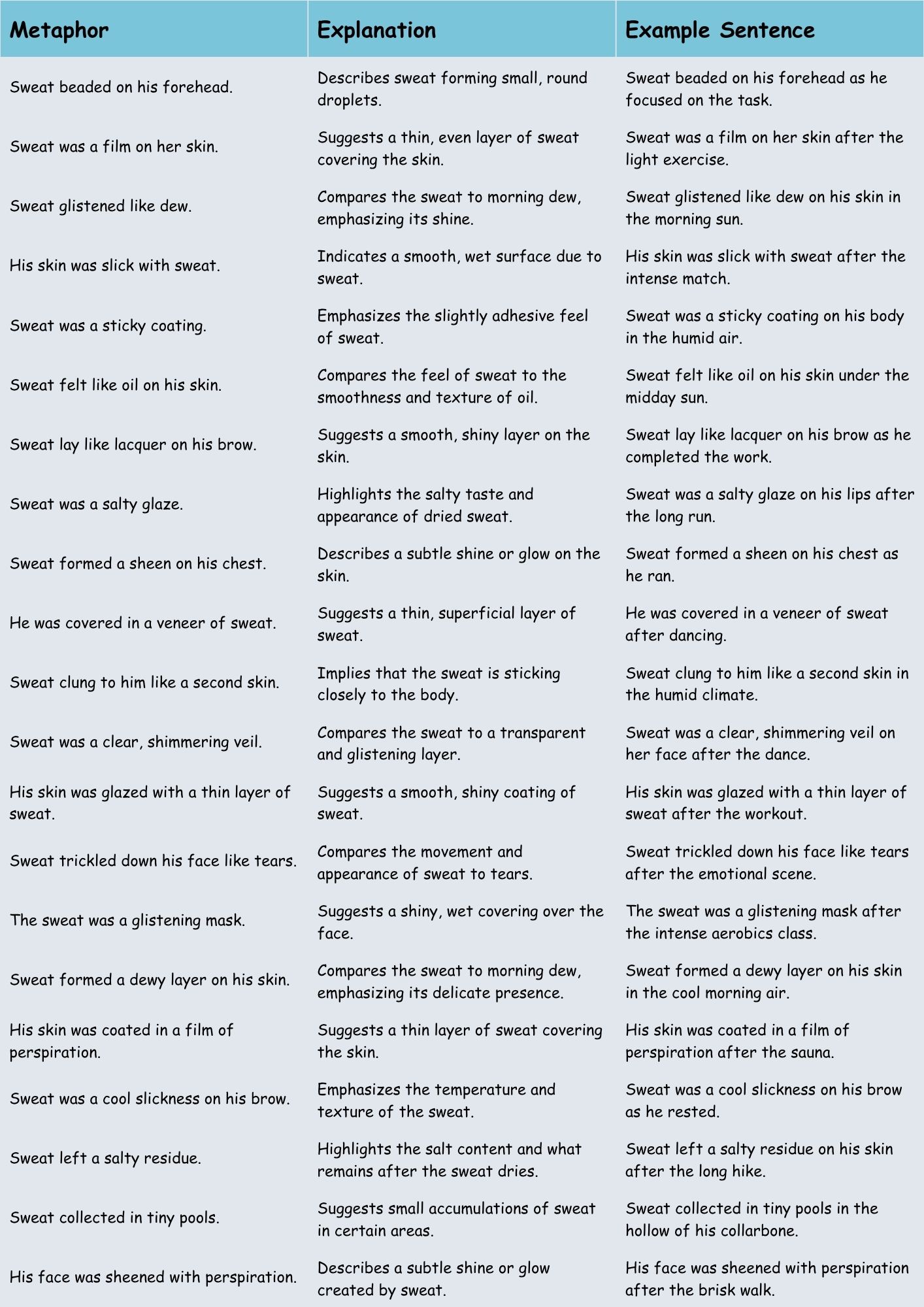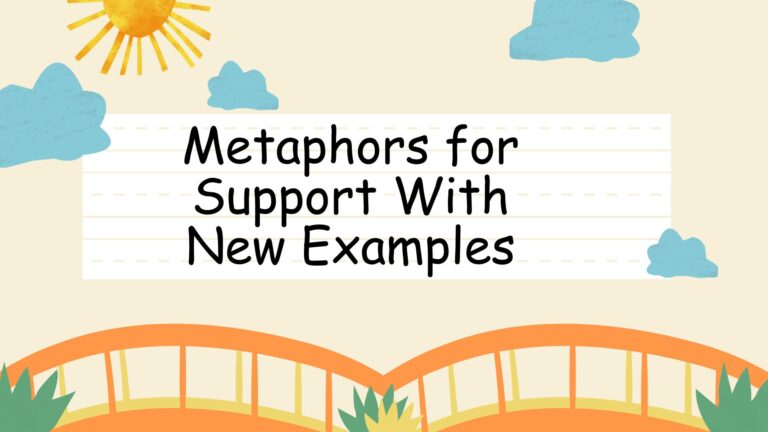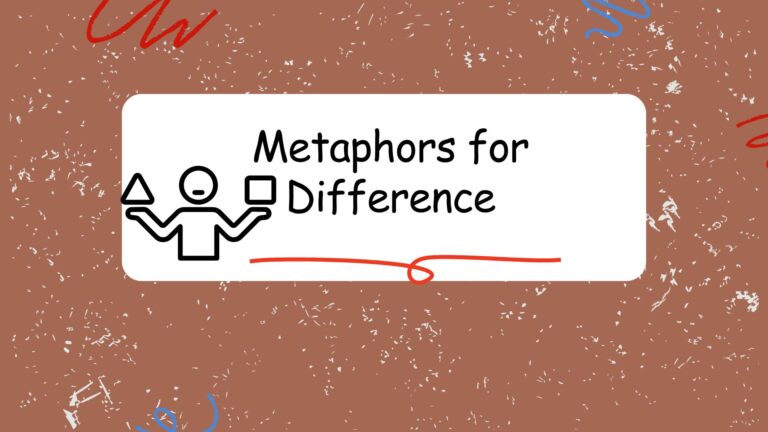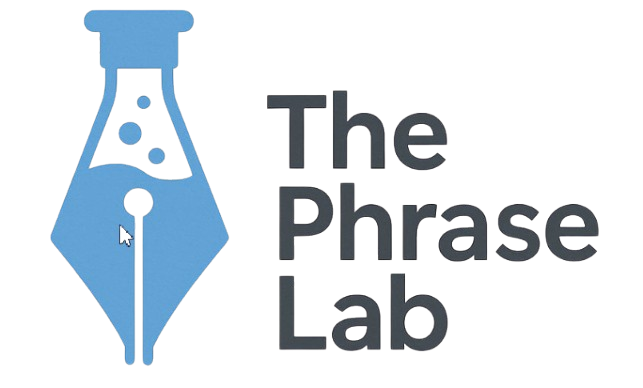
Metaphors for Sweating: A Comprehensive Guide
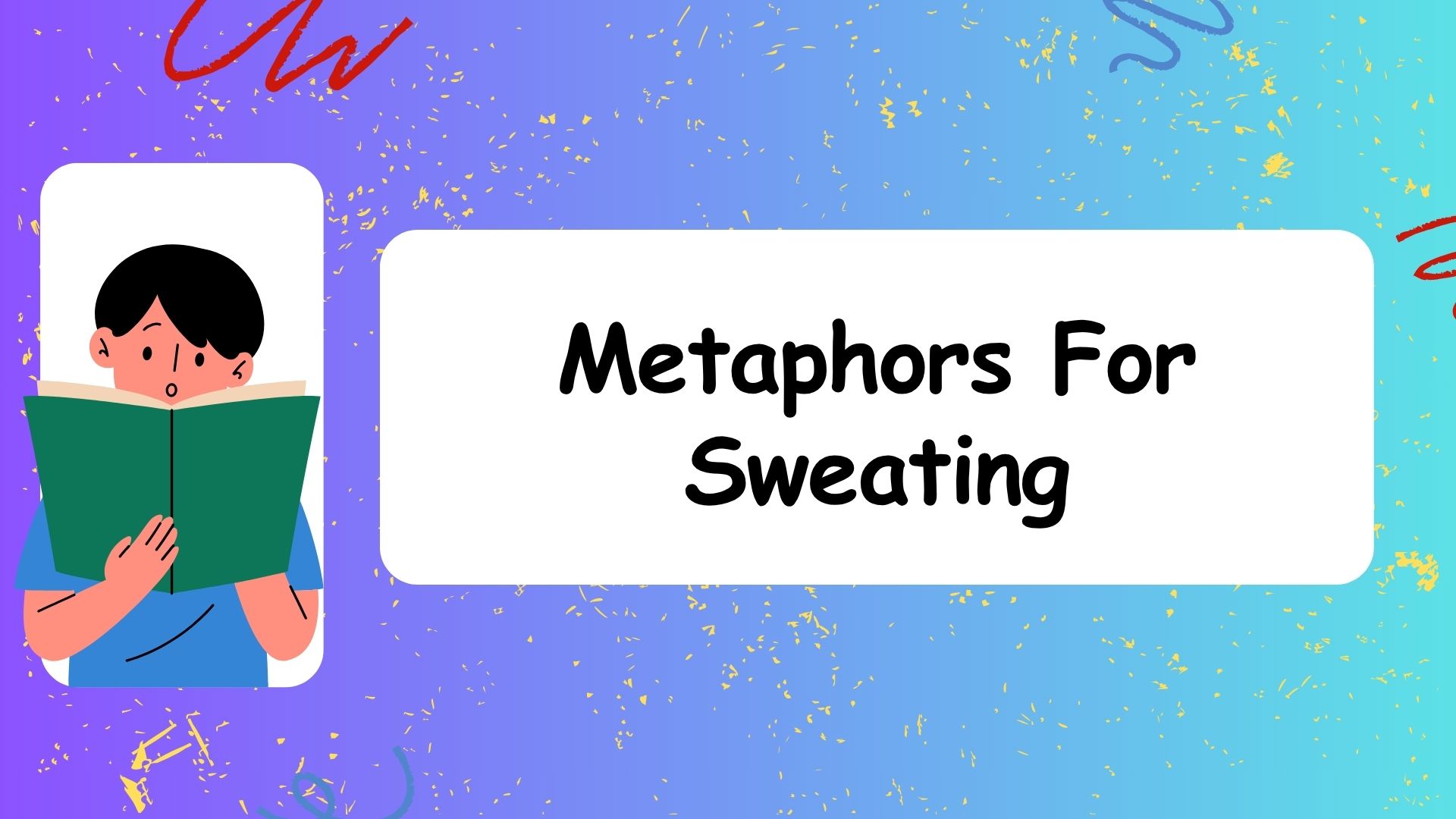
Understanding metaphors is crucial for mastering the nuances of the English language. Metaphors allow us to express abstract concepts in more vivid and relatable ways. When describing physical experiences like sweating, metaphors can add depth and color to our language. This article provides a comprehensive exploration of metaphors for sweating, explaining their meanings, usage, and impact. This guide is beneficial for English language learners, writers, and anyone looking to enhance their descriptive vocabulary and improve their understanding of figurative language.
This article will delve into the various metaphors used to describe sweating, analyzing their connotations and providing practical examples. By the end of this guide, you will be equipped with a rich vocabulary to express the sensation of sweating in diverse and imaginative ways.
Table of Contents
- Introduction
- Definition of Metaphor and Sweating
- Structural Breakdown of Metaphors
- Types of Sweat Metaphors
- Examples of Sweat Metaphors
- Usage Rules for Sweat Metaphors
- Common Mistakes with Sweat Metaphors
- Practice Exercises
- Advanced Topics in Sweat Metaphors
- FAQ
- Conclusion
Definition of Metaphor and Sweating
A metaphor is a figure of speech that directly compares two unrelated things, asserting that one thing is another, for rhetorical effect. Unlike similes, which use “like” or “as” to make a comparison, metaphors imply a similarity. Metaphors enrich language by adding layers of meaning and creating vivid imagery. They are essential tools for writers and speakers who want to engage their audience and convey complex ideas in a concise and memorable way.
Sweating, or perspiration, is the physiological process of excreting fluids through the skin’s sweat glands. This process is essential for thermoregulation, helping to cool the body down when it overheats. Sweating can be triggered by various factors, including physical exertion, high temperatures, stress, and certain medical conditions. The intensity and characteristics of sweating can vary greatly depending on the individual and the circumstances.
Combining these two concepts, metaphors for sweating allow us to describe the physical experience of perspiration in imaginative and impactful ways. These metaphors often draw on other physical phenomena, emotional states, or sensory experiences to create a more vivid and relatable image of sweating.
Structural Breakdown of Metaphors
Understanding the structure of a metaphor is crucial for effective usage. A metaphor typically consists of two main elements: the tenor and the vehicle. The tenor is the subject being described (in this case, sweating), while the vehicle is the object or concept used to describe the subject. The connection between the tenor and the vehicle is the ground, the shared characteristics or qualities that make the comparison meaningful.
For example, in the metaphor “sweat poured like a waterfall,” the tenor is “sweat,” and the vehicle is “waterfall.” The ground is the idea of a large quantity of liquid flowing rapidly. By understanding these components, we can better analyze and create effective metaphors.
Metaphors can also be classified based on their degree of explicitness. A dead metaphor is one that has become so common that it is no longer recognized as a metaphor (e.g., “the heart of the matter”). A conventional metaphor is a widely used metaphor that is still recognized as figurative language (e.g., “a flood of tears”). A novel metaphor is a fresh and original metaphor that creates a striking image (e.g., “sweat beaded like morning dew”).
Types of Sweat Metaphors
Metaphors for sweating can be categorized based on the types of imagery they evoke. Here are some common categories:
Metaphors of Quantity
These metaphors emphasize the amount of sweat produced. They often use imagery of large bodies of water or overflowing containers.
Metaphors of Intensity
These metaphors focus on the force or vigor of the sweating. They might use imagery of heat, pressure, or physical exertion.
Metaphors of Texture
These metaphors describe the feel or appearance of the sweat. They might use imagery of liquids, solids, or surfaces.
Metaphors of Emotion
These metaphors connect sweating to specific emotional states, such as fear, anxiety, or relief.
Metaphors of Origin
These metaphors describe where the sweat seems to come from, such as every pore or from deep within the body.
Examples of Sweat Metaphors
Here are some examples of metaphors for sweating, organized by category:
Metaphors of Quantity Examples
This table illustrates metaphors that emphasize the *amount* of sweat.
| Metaphor | Explanation | Example Sentence |
|---|---|---|
| Sweat poured like a river. | Compares the flow of sweat to a large, continuous stream of water. | After the marathon, sweat poured like a river down his face. |
| Sweat streamed down his back. | Implies multiple small rivers of sweat running down his back. | In the humid weather, sweat streamed down his back, soaking his shirt. |
| He was drenched in sweat. | Suggests being completely soaked, as if by a heavy rain. | He was drenched in sweat after the intense workout. |
| Sweat flowed like a waterfall. | Emphasizes the rapid and abundant flow of sweat. | During the hot yoga class, sweat flowed like a waterfall from her forehead. |
| A deluge of sweat covered his body. | Uses “deluge” to indicate a sudden and overwhelming amount of sweat. | A deluge of sweat covered his body as he sprinted to the finish line. |
| Sweat cascaded down her face. | Compares the sweat to a small, rapid waterfall. | Sweat cascaded down her face as she climbed the steep hill. |
| He was swimming in his own sweat. | Hyperbolically suggests a large amount of sweat. | After hours in the sauna, he was swimming in his own sweat. |
| Sweat gushed from his pores. | Implies a sudden and forceful outflow of sweat. | Sweat gushed from his pores as he performed the strenuous exercise. |
| Sweat rained down his forehead. | Compares the sweat to a gentle but persistent rainfall. | Sweat rained down his forehead as he worked in the garden. |
| He was bathed in sweat. | Suggests being completely covered, as if taking a bath. | He was bathed in sweat after his final performance. |
| The sweat was a flood. | A direct comparison, emphasizing the overwhelming amount. | The sweat was a flood after the intense cardio session. |
| Sweat poured off him. | Simple and direct, implying a substantial quantity. | Sweat poured off him as he worked in the sun. |
| He secreted buckets of sweat. | Implies a very large amount of sweat, comparing it to literal buckets. | He secreted buckets of sweat in the sweltering heat. |
| A river of sweat ran down his spine. | Emphasizes the continuous flow and direction of the sweat. | A river of sweat ran down his spine as he lifted the heavy weights. |
| Sweat overflowed from his brow. | Suggests an excessive amount of sweat, like a container overflowing. | Sweat overflowed from his brow as he strained to finish the race. |
| He produced a torrent of sweat. | The word torrent suggests a strong and uncontrolled flow. | He produced a torrent of sweat during the high-intensity interval training. |
| Sweat was a miniature downpour. | A vivid comparison, highlighting the intensity and volume. | Sweat was a miniature downpour after his intense workout. |
| His skin was awash with sweat. | Suggests being completely covered in sweat, like a surface covered in water. | His skin was awash with sweat after hours in the greenhouse. |
| The sweat was a veritable lake. | A hyperbolic metaphor, suggesting a very large amount of sweat. | The sweat was a veritable lake in his shirt after the hot yoga class. |
| Sweat streamed like a small creek. | Compares the flow of sweat to a small, continuous stream of water. | After the marathon, sweat streamed like a small creek down his face. |
| He emitted a tidal wave of sweat. | Suggests a massive and sudden amount of sweat. | He emitted a tidal wave of sweat after the grueling workout. |
| His body was a fountain of sweat. | Compares the body to a fountain, continuously emitting sweat. | His body was a fountain of sweat during the intense performance. |
Metaphors of Intensity Examples
This table showcases metaphors highlighting the *force* or *vigor* of the sweating.
| Metaphor | Explanation | Example Sentence |
|---|---|---|
| Sweat stung his eyes. | Suggests the sweat was intense enough to cause irritation. | The sweat stung his eyes as he pushed through the last mile. |
| Sweat burned as it trickled down. | Implies a painful or intense sensation from the sweat. | Sweat burned as it trickled down his forehead, a sign of his exertion. |
| He was sweating bullets. | An idiom indicating extreme anxiety or exertion. | He was sweating bullets before his job interview. |
| Sweat poured as if from a geyser. | Emphasizes the forceful and sudden eruption of sweat. | Sweat poured as if from a geyser after the adrenaline rush. |
| Sweat exploded from his pores. | Suggests a sudden and powerful release of sweat. | Sweat exploded from his pores as he reached the peak of his climb. |
| His sweat was a furnace. | A direct comparison, emphasizing the feeling of intense heat. | His sweat was a furnace, radiating the heat from his body. |
| Sweat hammered his skin. | Implies a forceful and relentless sensation. | Sweat hammered his skin under the blazing sun. |
| He was sweating like a horse. | A common idiom, indicating heavy and profuse sweating. | He was sweating like a horse after carrying all those boxes. |
| Sweat dripped like molten metal. | Compares the sweat to hot, liquid metal, emphasizing its intensity. | Sweat dripped like molten metal in the scorching heat. |
| His face was slick with sweat. | Suggests a smooth, wet surface due to heavy sweating. | His face was slick with sweat after the intense workout. |
| Sweat streamed with the force of a firehose. | A hyperbolic comparison, emphasizing the strength of the sweat flow. | Sweat streamed with the force of a firehose during the grueling race. |
| His body was an inferno of sweat. | A vivid metaphor, highlighting extreme heat and sweating. | His body was an inferno of sweat during the fever. |
| He was sweating like he was being boiled alive. | A dramatic metaphor, suggesting extreme heat and discomfort. | He was sweating like he was being boiled alive in the tropical climate. |
| Sweat gushed like a burst pipe. | Compares the flow of sweat to a sudden and uncontrolled release of water. | Sweat gushed like a burst pipe as he ran the final stretch. |
| His pores were volcanoes erupting sweat. | A powerful metaphor, suggesting a sudden and forceful release. | His pores were volcanoes erupting sweat during the hot yoga session. |
| Sweat cascaded with the intensity of a flash flood. | Emphasizes the sudden and overwhelming nature of the sweating. | Sweat cascaded with the intensity of a flash flood as he finished the marathon. |
| Each drop of sweat was a spark of heat. | Suggests that each drop contributes to an overall feeling of intense heat. | Each drop of sweat was a spark of heat, making the day feel even hotter. |
| He was sweating with the fervor of a blacksmith at his forge. | Compares the intensity of sweating to the energetic work of a blacksmith. | He was sweating with the fervor of a blacksmith at his forge during the intense work. |
| Sweat poured off him with the heat of a summer sun. | Links the sweating to the intense heat of the sun. | Sweat poured off him with the heat of a summer sun as he toiled in the garden. |
| He dripped sweat like a leaky faucet. | Suggests a continuous and unrelenting flow of sweat. | He dripped sweat like a leaky faucet after his sprint workout. |
| Sweat rained down like a tropical storm. | Compares the sweating to a heavy, intense rainfall. | Sweat rained down like a tropical storm during the peak of his fever. |
Metaphors of Texture Examples
This table provides metaphors describing the *feel* or *appearance* of sweat.
| Metaphor | Explanation | Example Sentence |
|---|---|---|
| Sweat beaded on his forehead. | Describes sweat forming small, round droplets. | Sweat beaded on his forehead as he focused on the task. |
| Sweat was a film on her skin. | Suggests a thin, even layer of sweat covering the skin. | Sweat was a film on her skin after the light exercise. |
| Sweat glistened like dew. | Compares the sweat to morning dew, emphasizing its shine. | Sweat glistened like dew on his skin in the morning sun. |
| His skin was slick with sweat. | Indicates a smooth, wet surface due to sweat. | His skin was slick with sweat after the intense match. |
| Sweat was a sticky coating. | Emphasizes the slightly adhesive feel of sweat. | Sweat was a sticky coating on his body in the humid air. |
| Sweat felt like oil on his skin. | Compares the feel of sweat to the smoothness and texture of oil. | Sweat felt like oil on his skin under the midday sun. |
| Sweat lay like lacquer on his brow. | Suggests a smooth, shiny layer on the skin. | Sweat lay like lacquer on his brow as he completed the work. |
| Sweat was a salty glaze. | Highlights the salty taste and appearance of dried sweat. | Sweat was a salty glaze on his lips after the long run. |
| Sweat formed a sheen on his chest. | Describes a subtle shine or glow on the skin. | Sweat formed a sheen on his chest as he ran. |
| He was covered in a veneer of sweat. | Suggests a thin, superficial layer of sweat. | He was covered in a veneer of sweat after dancing. |
| Sweat clung to him like a second skin. | Implies that the sweat is sticking closely to the body. | Sweat clung to him like a second skin in the humid climate. |
| Sweat was a clear, shimmering veil. | Compares the sweat to a transparent and glistening layer. | Sweat was a clear, shimmering veil on her face after the dance. |
| His skin was glazed with a thin layer of sweat. | Suggests a smooth, shiny coating of sweat. | His skin was glazed with a thin layer of sweat after the workout. |
| Sweat trickled down his face like tears. | Compares the movement and appearance of sweat to tears. | Sweat trickled down his face like tears after the emotional scene. |
| The sweat was a glistening mask. | Suggests a shiny, wet covering over the face. | The sweat was a glistening mask after the intense aerobics class. |
| Sweat formed a dewy layer on his skin. | Compares the sweat to morning dew, emphasizing its delicate presence. | Sweat formed a dewy layer on his skin in the cool morning air. |
| His skin was coated in a film of perspiration. | Suggests a thin layer of sweat covering the skin. | His skin was coated in a film of perspiration after the sauna. |
| Sweat was a cool slickness on his brow. | Emphasizes the temperature and texture of the sweat. | Sweat was a cool slickness on his brow as he rested. |
| Sweat left a salty residue. | Highlights the salt content and what remains after the sweat dries. | Sweat left a salty residue on his skin after the long hike. |
| Sweat collected in tiny pools. | Suggests small accumulations of sweat in certain areas. | Sweat collected in tiny pools in the hollow of his collarbone. |
| His face was sheened with perspiration. | Describes a subtle shine or glow created by sweat. | His face was sheened with perspiration after the brisk walk. |
Usage Rules for Sweat Metaphors
When using metaphors for sweating, consider the following rules:
- Context matters: Choose metaphors that are appropriate for the context. A metaphor suitable for describing exertion during a sporting event might not be suitable for describing nervousness during a presentation.
- Clarity is key: Ensure that your metaphor is clear and easily understood. Avoid obscure or overly complex metaphors that might confuse your audience.
- Consistency is important: Maintain consistency in your imagery. Avoid mixing metaphors that create conflicting or nonsensical images.
- Originality is valued: While conventional metaphors can be effective, strive to create original metaphors that are fresh and memorable.
- Consider your audience: Tailor your metaphors to your audience’s understanding and expectations. A metaphor that resonates with one audience might not resonate with another.
Common Mistakes with Sweat Metaphors
Here are some common mistakes to avoid when using metaphors for sweating:
- Mixed metaphors: Combining metaphors that create contradictory images.
- Incorrect: “He was sweating bullets and swimming in a sea of doubt.” (Combines intensity and quantity inappropriately)
- Correct: “He was sweating bullets before the exam.”
- Correct: “He was swimming in a sea of sweat after the marathon.”
- Clichéd metaphors: Overusing tired and unoriginal metaphors.
- Cliché: “He was sweating like a pig.”
- Better: “Sweat poured off him as if he had just stepped out of a shower.”
- Inappropriate metaphors: Using metaphors that are unsuitable for the context or audience.
- Inappropriate: “His sweat was a symphony of exertion.” (Too abstract for a simple description of sweating)
- Better: “Sweat streamed down his face, a testament to his exertion.”
- Overly complex metaphors: Using metaphors that are too convoluted or difficult to understand.
- Overly complex: “His sweat was the existential embodiment of thermoregulation’s futile attempt to reconcile homeostasis with the relentless march of entropy.”
- Better: “Sweat glistened on his brow as his body fought to cool down.”
Practice Exercises
Test your understanding of metaphors for sweating with these exercises:
Exercise 1: Identifying Metaphors
Identify the metaphors in the following sentences:
| Question | Answer |
|---|---|
| 1. Sweat was a river flowing down his face. | “Sweat was a river” |
| 2. He was drenched; sweat poured like a waterfall. | “Sweat poured like a waterfall” |
| 3. Sweat beaded on his forehead like morning dew. | “Sweat beaded… like morning dew” |
| 4. His body was an inferno of sweat. | “His body was an inferno” |
| 5. Sweat stung his eyes as he pushed through. | “Sweat stung his eyes” |
| 6. He was sweating bullets before the big game. | “Sweating bullets” |
| 7. Sweat glistened on his skin like lacquer. | “Sweat glistened… like lacquer” |
| 8. Sweat overflowed from his brow. | “Sweat overflowed” |
| 9. The sweat was a flood after the intense workout. | “The sweat was a flood” |
| 10. He emitted a tidal wave of sweat. | “Tidal wave of sweat” |
Exercise 2: Creating Metaphors
Create your own metaphors for sweating, using the following prompts:
| Prompt | Possible Answer |
|---|---|
| 1. Describe sweating after a long run. | Sweat painted his skin with a shimmering, salty glaze after the long run. |
| 2. Describe sweating during a stressful situation. | Sweat became a cold, clammy film, betraying his anxiety. |
| 3. Describe sweating in extreme heat. | The heat squeezed sweat from his body as if he were a sponge. |
| 4. Describe sweating during a workout. | Sweat was the currency of his effort, each drop a testament to his hard work. |
| 5. Describe the feeling of sweat drying on your skin. | The drying sweat left a map of salt on his skin. |
| 6. Describe the sound of sweat dripping. | Sweat dripped with the rhythm of a leaky faucet. |
| 7. Describe sweat on someone’s forehead. | Sweat gathered on his forehead like tiny, shimmering pearls. |
| 8. Describe the feeling of relief when sweat cools you down. | Each drop of sweat was a tiny wave of relief washing over his skin. |
| 9. Describe sweat after eating spicy food. | Sweat dotted his brow like tiny explosions of flavor. |
| 10. Describe sweat during a fever. | Sweat was a symptom of his body’s internal battle. |
Exercise 3: Correcting Mixed Metaphors
Correct the following mixed metaphors:
| Question | Answer |
|---|---|
| 1. He was sweating bullets and climbing a ladder of success. | He was sweating bullets before the presentation. OR He was climbing a ladder of success, one step at a time. |
| 2. Sweat was raining down like a symphony of discomfort. | Sweat was raining down like a tropical storm. OR The heat was a symphony of discomfort. |
| 3. His body was an inferno, but he kept his cool. | His body was an inferno of sweat. OR He was feeling the heat, but he kept his cool. |
| 4. He was swimming in sweat, a testament to his burning desire to win. | He was swimming in sweat after the race, a testament to his effort. OR His burning desire to win fueled his training. |
| 5. Sweat beaded on his brow, a tidal wave of anxiety. | Sweat beaded on his brow. OR A tidal wave of anxiety washed over him. |
| 6. His skin was a glistening mask on the path to success. | His skin was a glistening mask of sweat. OR He was on the path to success. |
| 7. The sweat poured off him like a furnace of effort. | The sweat poured off him. OR His effort was a furnace. |
| 8. Sweat was a sticky coating on a fast track to achievement. | Sweat was a sticky coating after the race. OR He was on the fast track to achievement. |
| 9. His body was a fountain of sweat, a mountain of determination. | His body was a fountain of sweat. OR He was a mountain of determination. |
| 10. Sweat was a river of effort, a burning desire to succeed. | Sweat was a river of effort. OR He had a burning desire to succeed. |
Advanced Topics in Sweat Metaphors
For advanced learners, consider exploring the following topics:
- Cultural variations in sweat metaphors: Different cultures may have unique metaphors for sweating based on their climate, traditions, and beliefs.
- The use of sweat metaphors in literature: Analyze how authors use sweat metaphors to create specific effects and convey deeper meanings.
- The evolution of sweat metaphors: Trace the historical development of sweat metaphors and how they have changed over time.
- The psychological impact of sweat metaphors: Explore how metaphors for sweating can influence our perception of physical exertion and emotional states.
FAQ
- What is the difference between a metaphor and a simile?A metaphor directly equates two things (e.g., “He is a lion”), while a simile compares two things using “like” or “as” (e.g., “He is like a lion”). Metaphors are more assertive and create a stronger sense of identification, while similes acknowledge a similarity without complete equivalence.
- How can I create more original and effective metaphors?To create original metaphors, try to think outside the box and make connections between seemingly unrelated things. Consider the specific qualities you want to emphasize and brainstorm images or concepts that share those qualities. Experiment with different combinations and ask for feedback from others.
- Are there any negative connotations associated with sweat metaphors?Yes, some sweat metaphors can have negative connotations, particularly those that associate sweating with fear, anxiety, or illness. Be mindful of the potential implications of your metaphors and choose them carefully to avoid unintended negative associations.
- Can I use metaphors for sweating in formal writing?Yes, but use them judiciously. In formal writing, clarity and precision are paramount. Choose metaphors that are clear, concise, and relevant to your topic. Avoid overly figurative or emotional language that might detract from your message.
- How do I avoid mixing metaphors?To avoid mixing metaphors, pay close attention to the images and concepts you are using. Ensure that your metaphors are consistent and do not create conflicting or nonsensical images. If you are unsure, try visualizing the combined metaphors to see if they make sense together.
- What are some common idioms related to sweating?Some common idioms related to sweating include “sweating bullets” (being very nervous), “sweating it out” (waiting anxiously for something), and “no sweat” (no problem). These idioms are often used in informal contexts and can add color to your language.
- How can I improve my vocabulary for describing physical sensations like sweating?Read widely and pay attention to how authors describe physical sensations. Use a thesaurus to find synonyms and related terms. Practice writing your own descriptions of physical sensations, experimenting with different words and phrases. Consider the different aspects of the sensation, such as its intensity, texture, and location.
- Why is understanding metaphors important for English language learners?Understanding metaphors is crucial for English language learners because metaphors are pervasive in everyday language, literature, and media. Without a grasp of metaphors, learners may struggle to understand idiomatic expressions, nuanced meanings, and cultural references. Mastering metaphors enhances comprehension and allows learners to communicate more effectively and creatively.
Conclusion
Metaphors for sweating offer a rich and diverse way to describe a common physical experience. By understanding the different types of sweat metaphors, their structural components, and the rules governing their usage, you can enhance your descriptive vocabulary and improve your ability to communicate effectively. Avoid common mistakes such as mixing metaphors and overusing clichés, and strive to create original and impactful metaphors that resonate with your audience.
Continue to practice using metaphors in your writing and speaking, and pay attention to how others use them. With time and effort, you will develop a keen eye for effective metaphors and a greater appreciation for the power of figurative language. Remember that metaphors are not just decorative flourishes; they are essential tools for conveying meaning, creating imagery, and engaging your audience.

